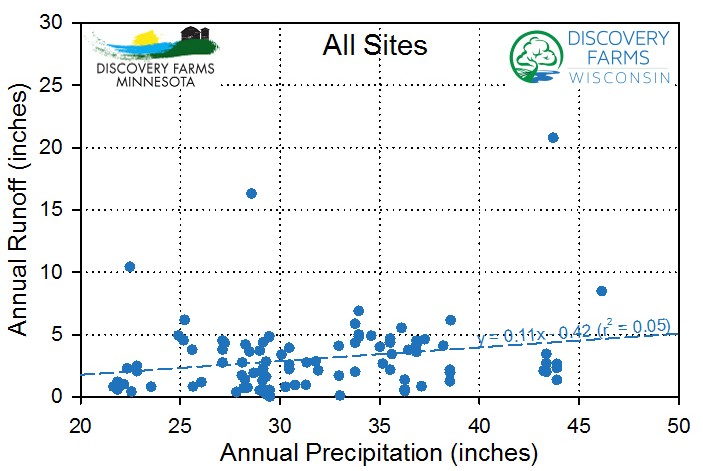It is usually thought that higher precipitation leads to higher surface runoff from agricultural fields. However, edge-of-field surface runoff research from the Discovery Farms programs in Wisconsin and Minnesota have documented that the amount of annual precipitation is a poor predictor for surface runoff. Figure 1 displays data from all Discovery Farms sites from 2004-2015. There is a positive correlation between precipitation and runoff, but it is very weak with a high amount of scatter in the dataset. There are many more factors than just precipitation that determine the amount of surface runoff, including soils, slope, crop type, and precipitation intensity and timing, which may explain some of the scatter in the dataset.

Even when assessing a single monitoring site with similar soils, slope, and crops from year to year, the amount of precipitation can be a poor predictor of surface runoff. Table 1 includes data from the site R1. This site is located in Southwest Wisconsin with silt loam soils and a 5% average slope. The field was in a corn-corn-soybean rotation and had consistent farm management practices throughout the study. In years 2005 and 2008 the crop planted was soybean following two years of corn. In 2005, there was 4.51 inches of runoff with only 27.12 inches of precipitation. In 2008, there was only 3.44 inches of runoff with 43.35 inches of precipitation. If precipitation was a good predictor of runoff for a site that had identical landscape factors it would be expected to have a similar runoff coefficient (runoff divided by precipitation). For this site the runoff coefficient was two times greater in 2005 compared to 2008.

Please check back tomorrow for part 2 of this blog which will explore why annual precipitation is poor predictor of surface runoff from agricultural fields by examining the role of precipitation timing and intensity.
- Lessons Learned from Schafer Farms – Implementing Conservation in a Rolling Landscape - April 8, 2020
- What happened to spring? - July 15, 2019
- Tile flow and nutrient movement in Northwest Minnesota - September 13, 2018